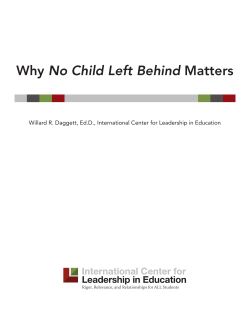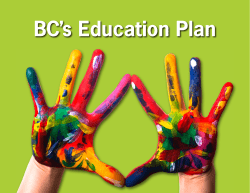
Your Child Plays... Explores...Learns ... Your Child and
Your Child Plays... ... Explores...Learns Your Child and Early Learning The Ministry of Education has developed the Play and Exploration: Early Learning Program Guide to support your preschool-aged child’s early learning. Child care centres and homes, Prekindergarten programs and preschools are encouraged to use the guide to enhance children’s learning. Learning through Play The Ministry of Education’s Early Learning Program Guide focuses on learning through play. Research shows that children learn best through play, and that play helps children learn the skills they need to do well in school, build relationships and understand others. Through play, your child learns to: • develop friendships; • listen to and understand a message or idea; • communicate ideas and feelings; • behave appropriately in a variety of situations; • focus and maintain attention on an activity; • solve problems; and, • enjoy literacy, science and math. Children learn many social, emotional, physical and intellectual skills by playing alone and with others. Play allows children to learn and practice appropriate behaviour in group settings, and it involves children in pretending, creating, reasoning and problem solving. What will you see in your child’s learning program? • interesting play materials, such as sand, water, clay, blocks, pinecones and leaves, that involve all your child’s senses—seeing, touching, tasting, smelling and hearing • your child happily and safely playing, pretending and exploring through: • dressing up • reading books • spending time in nature • hammering nails • drawing • talking • your child being creative and sometimes getting messy while painting, digging, climbing and building • opportunities for your child to play and explore ideas alone, with a few other children, or in a larger group with an adult Building on Children’s Interests When children explore something that interests them, they learn more quickly and remember what they have learned more easily. Choosing their own play also helps children develop key learning skills such as making decisions, solving problems and communicating with others. By building on children’s questions and curiosity, educators encourage language growth and more complex thinking. When children are excited about a topic, they can focus and are ready to learn key ideas in literacy, science and math. What will you see in your child’s learning program? • children choosing play materials and play partners • educators planning learning activities around the interests of the children • for example, children’s curiosity about their friends’ houses may lead to a photography and drawing project • educators interacting with small groups of children to enrich their play • for example, the educator knocking on the “door” of the house area to ask if she can come for dinner • educators answering children’s questions and helping them to understand new ideas • for example, exploring why cars go faster on steeper ramps • educators ensuring children understand how to safely use and care for tools and materials Showing Children’s Learning Families and educators can plan for new learning more effectively if they can see and understand what the child already knows. Some of the ways that families and educators determine what children know include: • looking carefully at children’s drawings, paintings and constructions; • listening to what children say to express their ideas; observing how children play and what they play with; and, • noticing how children play with others. Children’s learning is enhanced when they talk about what they have learned with their friends, families and educators. What will you see in your child’s learning program? • displays of photos and written descriptions of children’s learning experiences • children’s creative work such as drawings, paintings, clay creations or structures showcased instead of displays of identical crafts • adults and children talking about learning experiences and learning from each other Carefully displaying children’s work helps children think about what they have learned and understand that their ideas and work are valued. e? m o h t a o d u o y What can r. play partne ’s favourite ild h c r u playing o y ining in and jo You can be y b y la p and pretend imaginative Encourage uck, the ild: of a dump tr r with your ch ve ri d e th e doctor t be come ho is sick, th w • You migh g o d a checks gs the baby narian who nt who brin re a p veteri e th r o y hecks a bab who c w n to and follo doctor. ou can liste Y y. to the la p e th hild guide • Let your c ur peat what yo her ideas. lopment, re ve his or e e d e g d a n u to ex te th rage lang new words r o • To encou a e id w in d a ne hild to expla says and ad quire your c re t child a th s n io g. Ask quest learnin or “why.” barn for the “how” n be come a a c it d n a x o me box a cracker b with. That sa ys la p ild h Cut doors in c r ls you ild may farm anima ark. Your ch ic p st s la le p ic ll h a ve sm which toy a garage in can also be e s to practic ideas. opportunitie e d have more vi ro p a n a ars th t can as this c number of c e th • Play such s, w o c f goe s er o g (the numb brown house e tin h n (t u o rs c u lo o r naming c e garage) o e garage). fit in th n park in th a c k c u tr d nly the re first, o Show your child th at his or her work is important. Find a special spac e on a wall or on the front of the refrigera tor where your child ’s original drawings, pa intings and collage work can be displa yed. • Talk with your child about this work. Discuss what your child’s drawing shows and the way that it was created. You might begin the conversation with something like “I see that you have used lots of blu e squiggly lines here. Tell me about that.” More Ideas 2010legaciesnow.com/leap_bc/ has a FREE resource guide with 40 fun-filled activities encouraging learning through play and promoting physical activity, healthy eating, and a focus on early language development through rhymes, songs and stories. parentsmatter.ca offers a booklet called “Why Play” as well as a series of easy to read handouts in a number of languages. child-encyclopedia.com/en-ca/key-messages-list.html provides a series of parent brochures including “Child’s Play.” For more information on the Play and Exploration: Early Learning Program Guide, go to www.education.gov.sk.ca/ELCC
© Copyright 2025





















